Lucienne Diver's Blog: Lucienne Diver's Drivel, page 8
September 21, 2015
PERSEPHONE
 It sucks to have your whole mythological identity defined by your beauty and your kidnapping! Tale-tellers like to put a nice spin on things, calling your emergence in the spring and your vanishing back to the underworld after the harvest a metaphor for the growing season or the circle of life or some other drivel, but we see it for what it is…your brief furlough from prison.
It sucks to have your whole mythological identity defined by your beauty and your kidnapping! Tale-tellers like to put a nice spin on things, calling your emergence in the spring and your vanishing back to the underworld after the harvest a metaphor for the growing season or the circle of life or some other drivel, but we see it for what it is…your brief furlough from prison.
So, here’s the story: myth has it that ages ago on one of his rare excursions above-ground, Hades, god of the underworld, spotted Persephone picking flowers in a field and was instantly bitten*. Being one of the big gods and determined to get his way, when Persephone didn’t instantly swoon into his arms, he decided to kidnap her to the underworld and assure that she would stay by feeding her pomegranate seeds. How this was supposed to make her stay put, I have no idea. Possibly underworld pomegranates are special. Or this is like the food from faerie, or blood for vampires or any number of other mythological parallels, where once you’ve eaten something, there’s no going back. Other food is no longer nourishing. Anyway, the mythologies skip blithely over the fact that Persephone was taken and held against her will. Today this would involve massive jail time…and well deserved! Back in the bad old days, they called this marriage and even had the chutzpah to suggest that love grew from the pairing. To which I say horse pucky.
*My granddaughter Tori assures me the word is “smitten” but have you ever been frollicking through a field in bare feet or Grecian sandals? Bitten is the only way you emerge!
ERIS
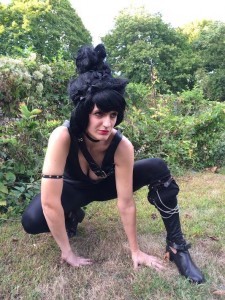 Discord. Stife. Yeah, Eris is all that and a bag of wormy chips. The daughter of Nyx (night), Eris was always a bit of a problem child. As such, she wasn’t invited to the wedding of power couple Peleus and Thetis. (Who invites discord to a wedding?) Upset at being slighted, Eris tossed a golden apple into the assemblage marked “To the fairest,” which sparked a squabble among Hera, Aphrodite and Athena, who were all convinced it referred to them. Zeus was smart enough to decline the judge’s chair when it was offered to him and instead thrust a mortal into the line of fire: Paris. You know, prince of Troy. The three goddesses tried to rig the decision. Each promised him something in their wheelhouse should he pick them, but he jumped at Aphrodite’s enticement—to have the most beautiful woman in the world for his wife. I’d comment about the vanity of men, but clearly there was more than enough to go around in this story!
Discord. Stife. Yeah, Eris is all that and a bag of wormy chips. The daughter of Nyx (night), Eris was always a bit of a problem child. As such, she wasn’t invited to the wedding of power couple Peleus and Thetis. (Who invites discord to a wedding?) Upset at being slighted, Eris tossed a golden apple into the assemblage marked “To the fairest,” which sparked a squabble among Hera, Aphrodite and Athena, who were all convinced it referred to them. Zeus was smart enough to decline the judge’s chair when it was offered to him and instead thrust a mortal into the line of fire: Paris. You know, prince of Troy. The three goddesses tried to rig the decision. Each promised him something in their wheelhouse should he pick them, but he jumped at Aphrodite’s enticement—to have the most beautiful woman in the world for his wife. I’d comment about the vanity of men, but clearly there was more than enough to go around in this story!
The long and short of it is that the most beautiful woman, with the face that launched a thousand (war)ships was Helen, who was already married to Menelaus of Sparta. Now, the movie The 300 hadn’t come out yet, so maybe the fame of the Spartans hadn’t quite spread far and wide, but really, Paris should have known better than to run off with another man’s wife. A powerful man at that. A king and brother to another king, Agamemnon of Mycenae, who was married to Helen’s sister, Clytemnestra. Can you say clusterf*ck, boys and girls? Of course you can.
Anyway, Eris accomplished what she set out to (she usually did)—strife, discord, war. As you might imagine, she was one of Ares’ boon companions.
Aliases: Discordia
EOS
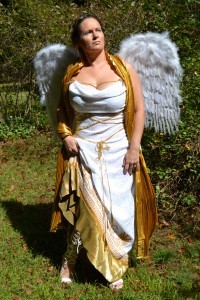 Eos, or, according to Homer, “rosy-fingered dawn” is a goddess/titaness associated—you’ve guessed it—with the break of day. She had the all-important role of opening the gates of the sun so that her brother Helios could ride through them pulling the orb across the sky with his golden chariot. What, you thought that was Apollo? The two did seem to get confused and even merged as mythology went on.
Eos, or, according to Homer, “rosy-fingered dawn” is a goddess/titaness associated—you’ve guessed it—with the break of day. She had the all-important role of opening the gates of the sun so that her brother Helios could ride through them pulling the orb across the sky with his golden chariot. What, you thought that was Apollo? The two did seem to get confused and even merged as mythology went on.
She was rumored to be a very beautiful woman who flitted about with the wings of a giant white bird…or even, dare I say it?…an angel! The dew was said to be her tears.
She was also said to have a pretty health appetite for beautiful young men. Hey, why should the gods have all the fun?
Well, okay, in this case the appetite was apparently Aphrodite’s curse over Eos’s affair with her lover Ares. As usual, though, it was the mortals who paid the price. Eos flew off with a few of the young men who caught her eye (like Cephalus who happened to already be married). With her lover Tithonus, she begged for and received for him immortality, but she forgot to include eternal youth. He was none too happy to live out his eternal march of tomorrow and tomorrow and tomorrows as a helpless old man.
Aka: Aurora, Thesan
PANACEA
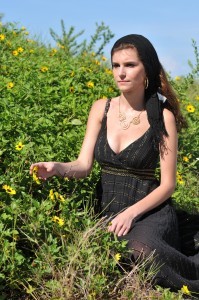 Panacea is probably the best known of Asclepius’s daughters, all of whom followed his healing path. She herself is a goddess of healing. The curative potion that she developed to heal the sick was the inspiration for the term panacea today—a universal cure.
Panacea is probably the best known of Asclepius’s daughters, all of whom followed his healing path. She herself is a goddess of healing. The curative potion that she developed to heal the sick was the inspiration for the term panacea today—a universal cure.
She still walks the earth, healing and soothing as best she can, though with much of her worship gone, she can no longer heal on a large scale but has to resort to the direct laying-on of hands.
Last known location: Africa, stemming ebola outbreaks.
July 28, 2015
Ireland – Day 5
Day 5: Westport House, Fjord, Flying the hawks at Ashford Castle, Cong Abbey
We’re in the habit of getting up and out early every day so that we have time to do everything possible, and today was no exception, especially since there was so much to fit in before our appointment to fly the hawks at Ashford Castle. (More on that soon!) First we headed to Westport House, since we were already in town. Unfortunately it didn’t open until 10 a.m. and by the time we’d have waited for it and taken the tour, we’d pretty much have put the kibosh on anything else.
If our son had been with us (and younger), we’d have planned to make an entire day of Westport, since in addition to the historical significance of the house and grounds, which were well-preserved, there was a Pirate Adventure Park (in honor of Grace O’Malley, the Pirate Queen of Connaught) with a carousel, zip lining, archery, canoeing, combat games and about everything else imaginable for the young-at-heart. Given our time crunch, we simply paid our fee to walk around the grounds of Westport House. The house that stands now dates to 1730, but the original Westport House was built in 1650 by Colonel John Browne and his wife Maud Burke, who was Grace O’Malley’s great-great grandaughter.
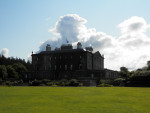
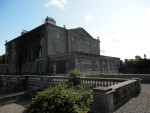
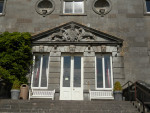
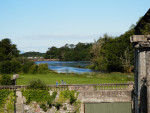
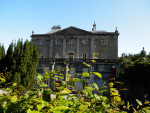
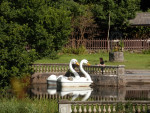
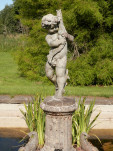


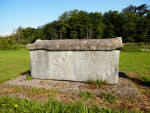
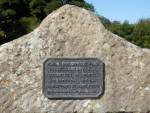
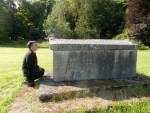
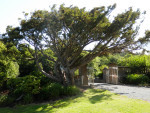
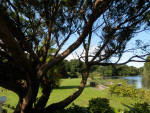
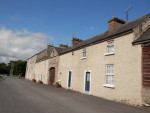
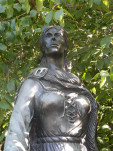
Then we were on to Killary and the only fjord in Ireland, which we’d added spontaneously to our schedule after hearing about it from a local. We’d never seen a fjord before and couldn’t miss the chance to do so now! So, we gathered our travel chocolate, as had become a tradition with us to help the miles go by (dark chocolate whiskey truffle bars, mostly), and headed off. It was beautiful, as you can see, though since we’d had no idea what to expect, we might have built it up a bit bigger in our heads…
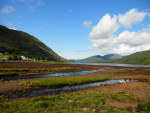
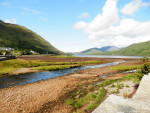
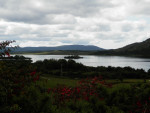
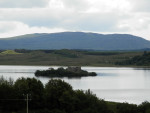
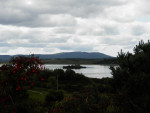
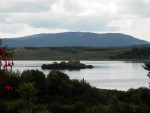
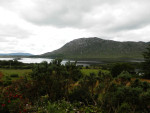
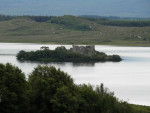
It was just as well that the fjord didn’t require a hike to reach, because we had an appointment at the Irish School of Falconry beside Ashford Castle in Cong for a “Hawk Walk” on the grounds.
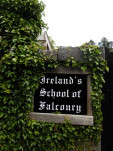
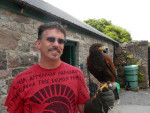
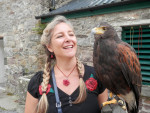
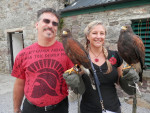
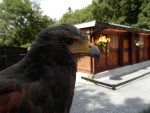
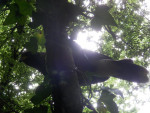
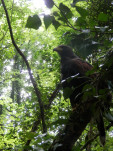
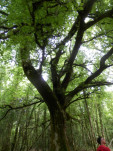
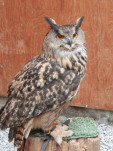
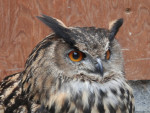
This was without question one of the high points of our trip. For the cost, we got a private lesson in falconry and a personal guide. It was just Pete and me, our guide Anya, and our brother and sister hawks Beckett and Sonora. Both were Harris hawks (originally of Colorado), since they’re the only ones that will fly and hunt communally. The hawk walk was…there are just no words. It was amazing. Magical. We learned about how the falconers know when to fly them. Harris hawks are generally between one and two pounds and their weights are recorded every morning, because they should be flown when they’re just hungry enough that they want to hunt, but not so hungry that they’ll make bad choices, as we humans do at fast food counters. Beckett was a very well behaved hawk, but it turns out Sonora was addicted to mushrooms, which she can’t really digest, and so she kept ignoring our guide’s calls to return to fill her crop with fungi! She did come back around, however, and it was an absolutely amazing day. We also got to see and hear about other birds as well, like the peregrine falcon, which can fly up to speeds of 273 mph and needs wide open spaces because of its speed, wingspan and prey (it hunts other birds). We also met Dingle, the Indian Eagle Owl, who was absolutely beautiful!
Also in Cong was the gorgeous Cong Abbey, pictures of which are below. It turns out that in Cong and Connemara, they’re all about the film The Quiet Man with John Wayne and Maureen O’Hara, which was set in the area. There’s memorabilia everywhere, and I quickly snapped a picture of this statue on the way to the abbey.
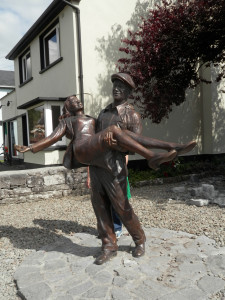
OLYMPUS DIGITAL CAMERA
The abbey was beautiful, and I’m so all about the Celtic high crosses it’s ridiculous. There’s a good write-up of the history here, so I won’t go over it all myself except to say that the architecture that remains dates back to the 12th century.
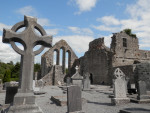
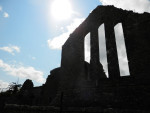
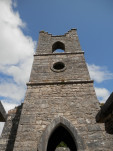
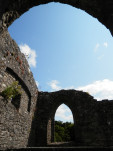

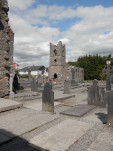
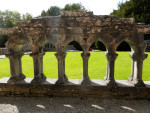
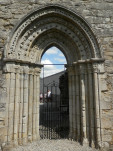
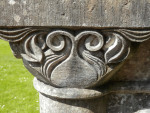
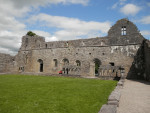
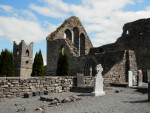
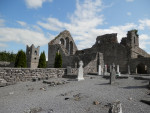
Dinner involved probably the most amazing desert we had during our time in Ireland, chocolate Guinness cake. A quick note: there should be absolutely no question of what to order anywhere in Ireland once you see the word Guinness in a description. To quote Monk’s theme song (the OCD detective, not someone who might have lived at the abbey), I could be wrong now, but I don’t think so…


July 27, 2015
Ireland – Day 4: Part 2
Day 4: Neolithic Passage Tombs in County Leitrim and Westport, County Mayo
We did have a very nice lunch at the tea room, as advertised, and then went on a search for neolithic passage tombs in Manorhamilton, County Leitrim…. Now, it was a wonder we’d heard about these tombs at all. I saw them listed on an attraction-side map somewhere in Duncliff and hoped their label (Tullyskeherney ) would lead us to them. Unfortunately, there were no road names to indicate how to reach them, just a green line extending out from a town labeled Manorhamilton. Our GPS, of course, had no idea, since passage tombs don’t exactly come with a street address…and yet when I said to my husband, “Let’s go. We’ll ask the locals,” he agreed instantly. Forty-five or so minutes later (I think, I didn’t note the time), we were at a petrol station in Manorhamilton asking the young man and woman behind the counter. They had no idea, but were very nice, which was true of all the people we encountered in Ireland, and the girl’s eyes lit up with an idea. “Wait, I know who might know!” She was off, and a minute later came back to wave us in the direction of two older men bent over their coffees like they were pints at the pub. The man were glad to see us interested and told us we couldn’t miss it. We were to take a right turn after the cattle market and go up and up the mountain, veer left when the road separates, and keep going. If we found ourselves coming back down again, we’d gone too far. Well, we all know “can’t miss it” is code for “good feckin’ luck!” but we were determined and excited. So, as instructed, we went up and up the mountain, searching all the while into the sheep pastures looking for the tombs and not seeing them. When we’d gone up as far as we could go and were in danger of heading back down the mountain, Pete’s eyes lit with mischief, and he stopped the car, pulling as far to the side as he could on the narrow, one-lane road. He rolled down the window and asked the sheep, who looked at him in utter amazement, then looked at each other to see whether they should answer. Once some sort of sheeply consensus had been reached, they turned and started heading even further up the mountain than was possible by car. Pete wondered whether we should follow the sheep, but I didn’t want to trespass on someone’s property and wasn’t so sure about letting ourselves into their pasture.
Instead, we went a bit further (now heading down the mountain) and found a house where no one seemed to be home. We got back into the car, headed the other direction down the mountain until we found another house with the world’s friendliest dog…and people too! The woman there assured us that the top of the mountain where we’d been was absolutely right, the sheep knew what they were talking about, and we should use a set of wooden steps someone had built and placed over the paddock fence to let ourselves in. Thus armed with permission and directions, we did just that. The sheep, since we hadn’t taken their direction now wanted nothing more to do with us, so we picked our way through sheep patties until we came upon not just one passage tomb, but an entire hillside of them! As you can see, this was very impressive, despite the fact that the tombs had clearly been raided for stone to build a now-abandoned shepherd’s cottage nearby (based on the similarity of stone not in evidence elsewhere on the mountain and the matching tool marks). Yet you can still see the basic configuration of the tombs and the ancient tool marks. It was amazing!
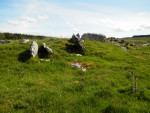
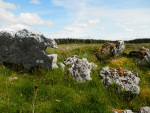
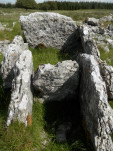
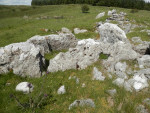
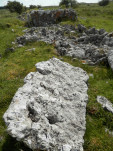
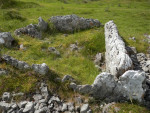
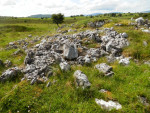
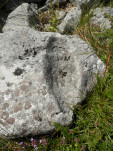
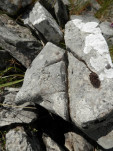
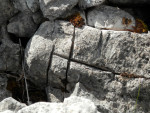
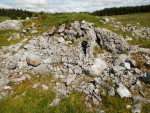
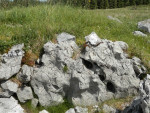
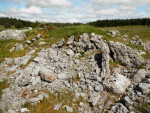
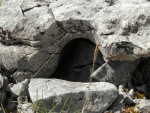
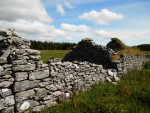
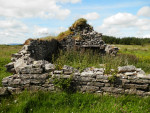
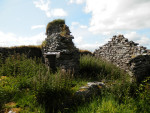
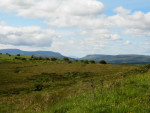
After communing and geeking out for awhile (I was an anthropology major as well as English/writing, so I eat this stuff up), we were own to our accommodations for the night—in Westport, County Mayo. I’d never even heard of Westport, which is a beautiful seaside resort town that many French but few American tourists visit apparently, based on our conversation with a couple of lovely locals on our stroll out to see the sunset.
Voracious from our hike, we received a recommendation on a place to go for dinner and were told unequivocally to visit The Helm. What a great recommendation. Pete and I both had the rack of lamb, which you could not quite have cut with a butter knife, but it was probably a near thing. It was so good and we were so full that we decided to take that aforementioned walk to see the sun set, which happened at about 10ish at that time of the year, to work up our appetite again.
The landscape was gorgeous, even before sunset, with Croagh Patrick (a sacred mountain on top of which Saint Patrick was rumored to have fasted for 40 days) in the background.
Clouds came in and hung around that kept it sunset from being as impressive as it could have been (and we were told had been the previous night), but it was still beautiful, and our stroll and talk with the nice Irish couple and their crazy-energetic dog was wonderful. We discovered that they were related to Aoife Beary, one of the students who’d survived the balcony collapse in Berkley ,CA where six students were killed and seven seriously injured. She was still unconscious, but as of yesterday, the update we saw said that she’d been moved off of the critical list. Prayers for healing for Aoife and the other students and families are still very welcome.
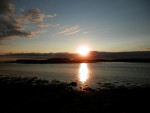
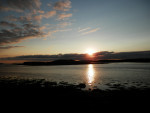
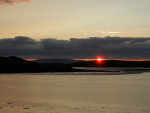
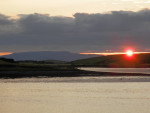
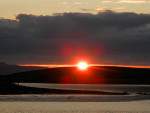
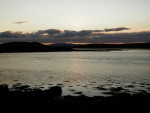
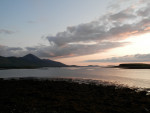
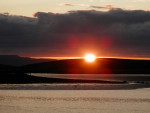
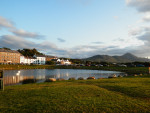
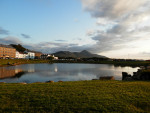
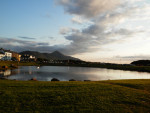
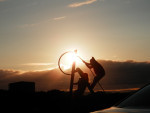


Ireland – Day 4: Part 1
Day 4: Donegal Castle, The Dubliners (sadly not in person), Rossnowlagh Beach and Yeats’ Grave
We started today with a leisurely walk (and shopping!) around the town of Donegal, seat of the county of Donegal. When we’d killed enough time and spent enough money, we hared off to the castle there, which was built around 1494, but upon a site dating back much further at the very least to a Viking stronghold in 900. The first Red Hugh O’Donnell was an Gaelic chieftan who could trace his lineage all the way back to Niall of the Nine Hostages, who I had to look up once I was home and who had a very colorful history. Eventually, it was taken over by another Red Hugh, who burned it to the ground at the end of the Nine Years War to keep it from falling into English hands…which, of course, it did anyway. Thus Captain Basil Brooke and his family took over, rebuilt, and added a manor house, which they later left when they were granted larger holding in Ulster. I was amused that they took the roof with them to avoid England’s roof tax (as one does, apparently, because this wasn’t the only time we heard this story!)
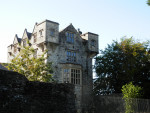
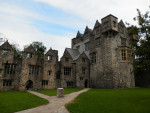
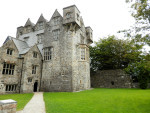
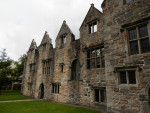
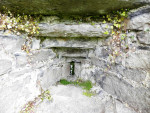
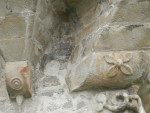
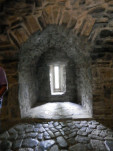
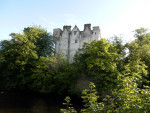
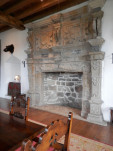
We stopped at a music shop in Donegal before leaving to buy good Irish music, since the few radio stations seemed to have talk, country (the country seemed obsessed with country music) or weird pop-rap. Okay, I know “weird” is judgmental, but let’s just say not our cup of tea. We bought a three disk set of The Dubliners, and thank goodness for that! Perhaps our favorite song on the disks was “The Sick Note”. Trust me, it’s worth the listen.
Then we were off to Rossnowlagh Beach, which was recommended to us by a very nice woman at the hotel. It was, as you can see, beautiful, but also windy and a I couldn’t have imagined being in the water (chilly), but many people were, some learning to surf. Also, there were many cute dogs being walked. A beautiful seaside resort area.
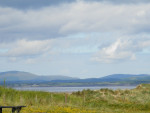
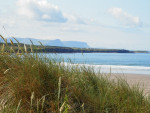
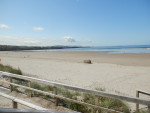
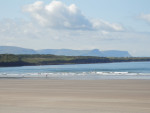
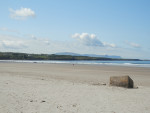
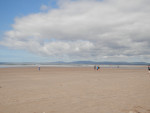
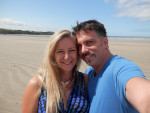

Then, of course, we had to visit Yeats’ grave. We were warned that it wasn’t that the grave itself was so impressive as that, well, it was something that probably had to be done and that there was a lovely tea shop nearby. She was right that the grave was not impressive of itself. Yeats had died and was buried initially in France but he was later (per the wishes he’d expressed) moved and reburied in Drumcliff, Ireland at a church where a relative (grandfather or great grandfather, I forget) had been rector. There are rumors, though, that the body that made it back wasn’t Yeats’…or at least not his entirely!
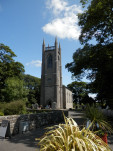
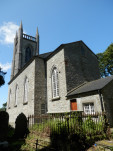
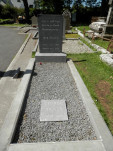
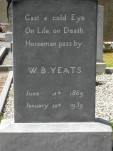
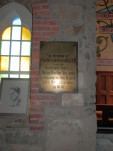
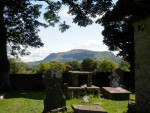
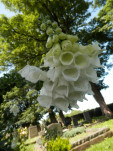

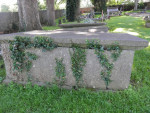
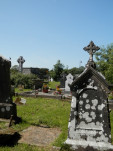
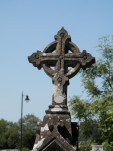
If you’re not familiar with Yeats, you have to read A Dialogue of Self and Soul for a taste. Yes, have to. I’m bossy like that.
We did have a very nice lunch at the tea room, as advertised, and then went on a search for neolithic passage tombs in Manorhamilton, County Leitrim…. To be continued!


Ireland – Day 3 Evening
Interlude: evening of Day 3: Napoleonic anchor and Franciscan Abbey in Donegal Town
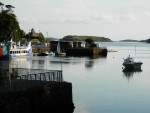
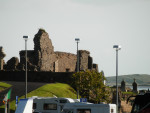
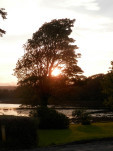
I realized in going over my pictures from the trip that I neglected to post about the end of day three, which involved the anchor from a Napoleonic ship and might…hypothetically…have involved us jumping a stone wall when we somehow missed the entrance (or even the road) leading to the old abbey in Donegal (despite the fact that you could see it from where we’d eaten dinner).
Yeah, I have no sense of direction. For those who know me, this comes as no surprise.
The anchor came off the Romaine, a frigate from a small fleet Napoleon sent to help the Irish against the British in 1798. Unfortunately, the ships were spotted by watchers loyal to England and sunk or captured. See how well my husband wears it on his arm and my pretty poor attempt to look like a pin-up girl. Not to self: do not give up day job.
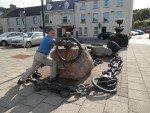
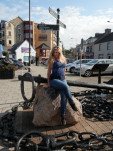
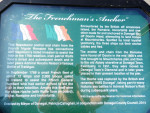
Anyway, the abbey was certainly worth seeing. According to sources, it was built in 1474 by Hugh O’Donnell (the Irish did like their Hughs) and Wiki says it “withstood ransacking, burning and ravaging before it was finally abandoned in the early part of the 17th century.” The cemetery, however, was not abandoned, and continued in use for many, many years. The abbey was apparently the place where the Annals of the Four Masters was written to preserve as much as possible of the Celtic culture and history of Ireland, which, it seemed, the English had tried pretty hard to stamp out.
I am now determined to get my hands on an edition.
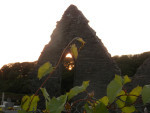
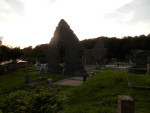
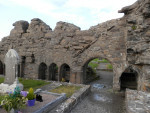
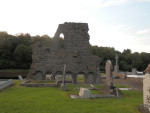
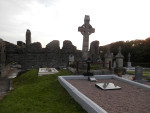
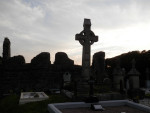
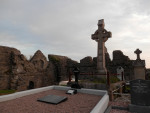
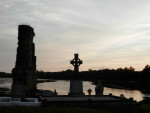
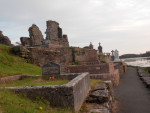
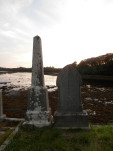
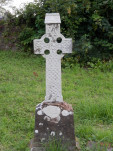
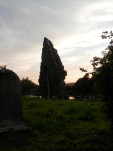
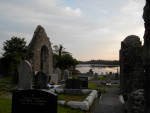
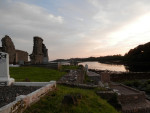
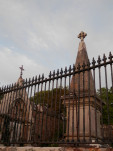
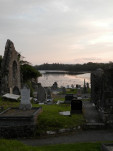


July 23, 2015
Ireland – Day 3: Glenariff Forest Park, the Dark Hedges, Dunluce Castle, Walled City of Derry
Day 3: Glenariff Forest Park, the Dark Hedges, Dunluce Castle, Walled City of Derry
Day three started at the beautiful Glenariff Forest Park, which wasn’t far from where we were staying in Antrim. We took the waterfall walk because…well, waterfall! You can see for yourself the natural beauty, though no picture has ever done justice to a waterfall, which has to be experienced in the rushing sound, the spray on your face and the elemental power you feel just being close to it. It was quite the walk (I want to say two miles, but all of those up and down some pretty steep slopes) and our calves were burning by the time we made our way back up to our car.
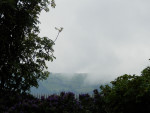
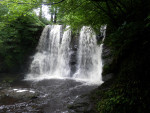
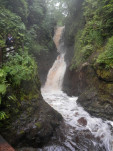
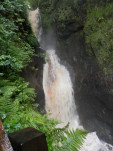

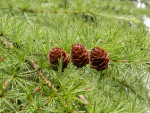

From there it was on to the Dark Hedges. By now we had the GPS figured out, and we didn’t get lost, though we did get stopped by a parade in celebration of July 12th, otherwise known as Orangeman’s Day, where in Northern Ireland they commemorate the victory over the Protestant king William of Orange over the Catholic king James II in 1690 at the Battle of the Boyne. There were concerns over violence breaking out over the parades, since tensions can still run high, as we saw at a couple of protests, but there was none at this small parade in Ballymoney. (The right Ballymoney this time.)
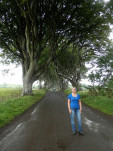
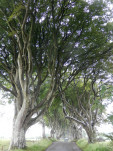
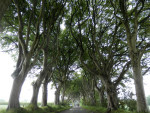
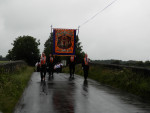
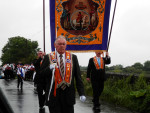
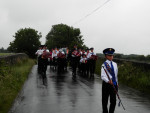
For those who don’t know, after their conquest, the British used the plantation method of planting their own people on Irish lands, “acquiring” them from chieftans and lords not ready to leave. They tried to wipe out Catholicism and impose their own religion as well as rule. The Feckin’ Book of Irish History, which I can highly recommend, has a great quote from Quentin Crisp: “When I told the people of Northern Ireland that I was an atheist, a woman in the audience stood up and said, ‘Yes, but is it the Catholic God or Protestant God in whom you don’t believe?'” To me, it’s all the same God and I don’t think he or she is very excited over all the violence committed in his/her name, but no one ever asks me.
Anyway, the Dark Hedges (portrayed in Game of Thrones) were cool, but I expected an entire woodland of trees growing thickly and eerily together instead of a single copse of trees along a roadway. Still, neat, as you can see.
Next we hit Dunluce Castle, the first we’d had time to tour internally since our arrival. Dunluce Castle was beautiful and extensive, built around 1500 by the MacQuillan family, who didn’t have very long to enjoy it before it was seized by the MacDonnell’s. An entire town grew up around it, as they do, but was burned along with the castle in the Irish Uprising of 1641 and the site was abandoned by the 1680s. Discover Northern Ireland says that Dunluce Castle was potentially the inspiration for Cair Paravel in the Chronicles of Narnia by C.S. Lewis. Just look at the pictures and you can see how the site might have been inspiring!



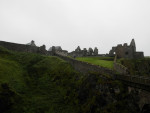
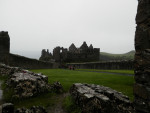
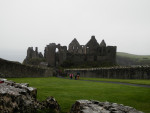
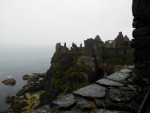
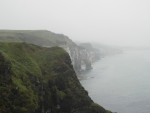
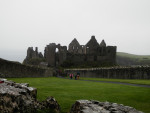
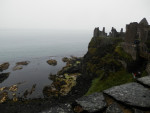
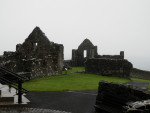
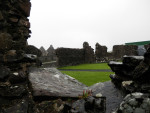
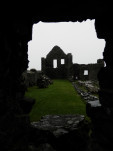
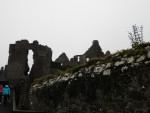
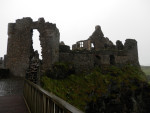
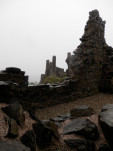
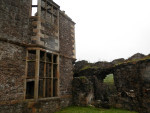
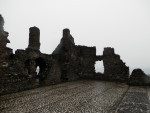
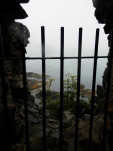
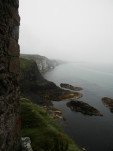
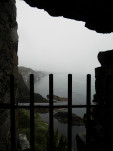
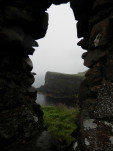
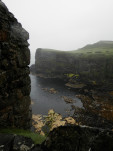
From there it was on to the Walled City of Derry, where we walked the walls and also visited the impressive Guildhall, which we would have sworn was a church before we got a closer look. The brochure we picked up says that the walls were built between 1613 and 1618 to protect the English and Scots settlers who were planted there in order to take over and “bring the rebellious Gaelic region firmly under control”. The city was rechristened Londonderry, which to this day hasn’t entirely taken, which we know from reading as well as signs with London stricken out with graffiti along the way.
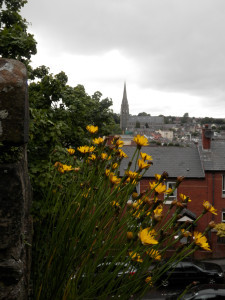
OLYMPUS DIGITAL CAMERA
We entered through the Bishop’s Gate (one of the four original gates), which put us close to Saint Columb’s Cathedral, which interested me because of its beauty, but also because our home church back in Maryland was St. Columba’s (same saint, different spelling). We weren’t able to tour the cathedral, since it was closed, possibly to protect it from any protests or problems arising from the celebration of the day, but the pamphlet we picked up says that it was built around 1633, and was “the first Cathedral in the British Isles to have been built after the Reformation and is a fine example of “Planter’s Gothic.” The building was virtually unchanged until 1776 when the then-bishop added 21 feet to the tower and spire. Unfortunately, it wasn’t terribly structurally sound and was taken down before it fell down and replaced.
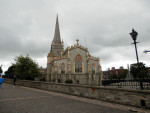
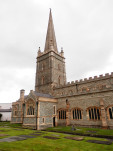
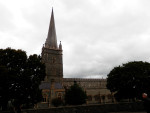
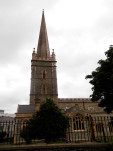
On the walls, we found many wonderful faces, like this one we’d swear must be a forbearer of our friend Glenn Hauman. (Traveling right now, but check back for a pick of him posted alongside this one for your amusement.)
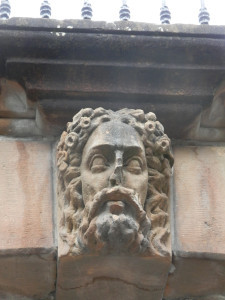
OLYMPUS DIGITAL CAMERA
We also found this more modern statue, which I called the Man in the Iron Mask and which Pete decided was The Man in the Iron Onesie. The real story behind it is much nicer (see plaque) and related to both sides (the Protestant and the Catholic) seeing things through each others’ eyes.
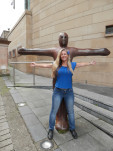
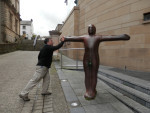
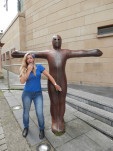
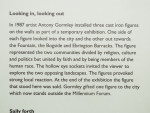
The Peace Bridge, likewise, was about bringing both sides together and relegating conflicts to the past.
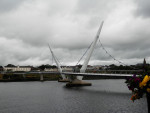
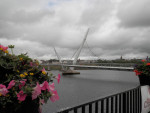
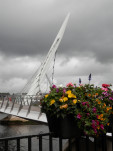

The most impressive structure in the city, at least to us, was the Guildhall, built in 1887, which had a wonderful exhibition talking about the plantation period. Fascinating by itself, but our favorite part was arguably the gorgeous stained-glass windows. I say arguably because I haven’t actually consulted Pete on the matter, but, well, just look… (My favorite, BTW, is the seahorses-play-poker panel.)
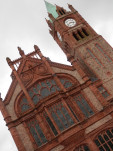
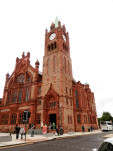

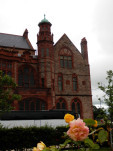
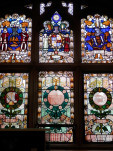
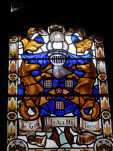
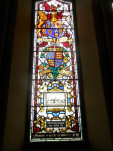
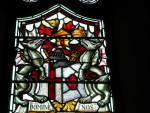
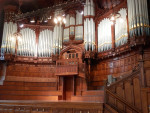
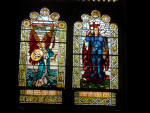
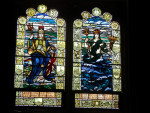
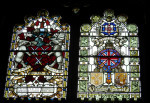
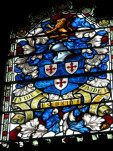
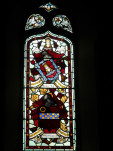
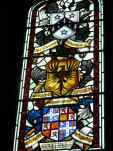
We were off that night for Donegal, but not before we discovered that either our memory of sticky toffee pudding from our time in England had either been inflated or it just wasn’t the same in Ireland (at least where we’d been eating it). Dinner that night, however, did not disappoint in the least…slow roasted beef. Yum!
Side note: they have Emo gas in Ireland. You have been warned.


July 21, 2015
Ireland – Day 2: Giant’s Causeway, The Carrick-a-Rede Bridge, Bonamargy Friary
Day 2: Giants Causeway, The Carrick-a-Rede Bridge, Bonamargy Friary
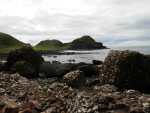
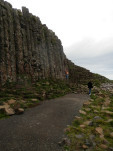
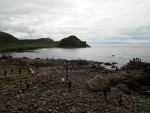
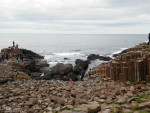

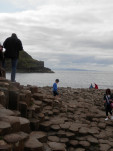
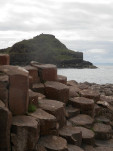
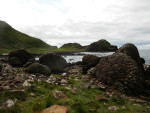
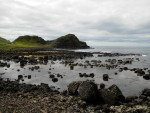
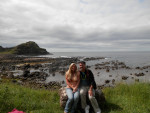
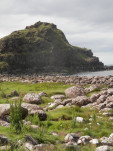
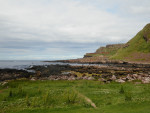
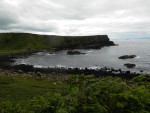
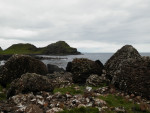
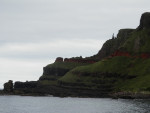
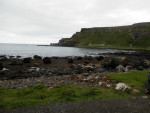
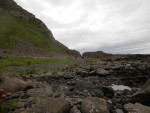
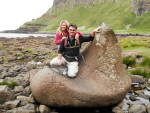
This was one of the great days, even though we got off to the wrong start. We programmed Ballymoney into the GPS to head toward the Dark Hedges (from Game of Thrones) and were pleased to see that our destination was only an hour away. Unfortunately, it turned out to be an hour in the wrong direction! It seems there are several Ballymoneys throughout Ireland, and unless you’re specific with the GPS about what county you’re in, it’s going to take you to the closest. Once we got ourselves figured out, we were back on the road, this time headed for Giant’s Causeway, since as Highlander would say, There can be only one.
It was a long drive, but so well worth it, as you can see for yourself. The beauty and the landscape were almost otherworldly, a result of volcanic and geological activity. The columns you see are basalt and, get this, made of interlocking hexagonal stones! The site encompassed three bays, each just as beautiful as the next. And the legends! Loved them. It seems that Fionn mac Cumhaill, the giant who lived at the causeway (evidenced by the remains of his pipe organ still seen on one of the peaks…or chimney stacks, depending on who you listened to) was in the habit of shouting back and forth to the giant he could see across the way in Scotland—the typical gianty “grind your bones to make my bread” sort of banter. One day Fionn (pronounced Finn) decided to take up the challenge and built a bridge of columns across the water. But on getting closer and seeing the size of his opponent, he decided to give it up and fled back across the bridge, losing one of his boots in the process. The Scottish giant, Benandonner, hot on his heels, Fionn retreated to his home, where he took to his baby’s cradle, bonnet and all. When Benandonner came calling, Fionn’s wife told him there was no one home but her and the baby. When Benandonner got a look at the giant child, he reasoned that the child’s da would be too big to challenge and fled back across the bridge, destroying it as he went. Thus ending the only story in Irish history that went off without a fight! There were other great stories. On another peak, you can see Fionn’s gran, who he turned to stone when she wouldn’t give up the drink (harsh!).
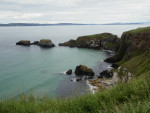
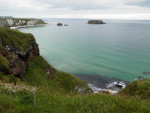


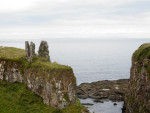
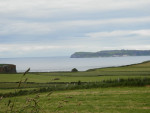
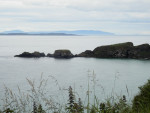
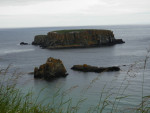

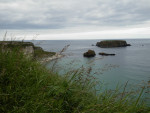
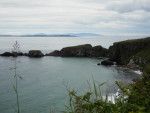
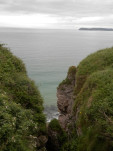
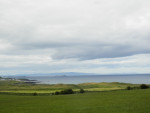
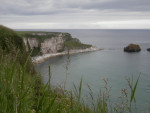

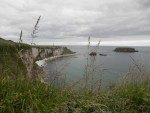

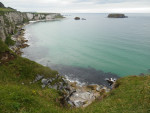
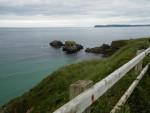
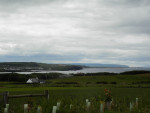
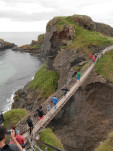
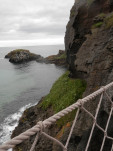
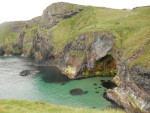
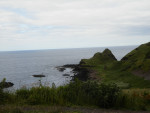
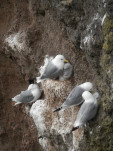
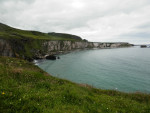
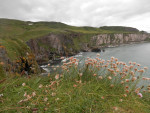
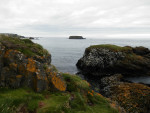
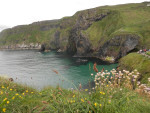
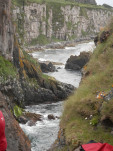
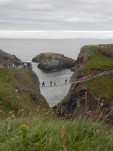
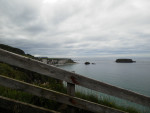
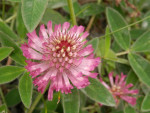
Next we were on to the impressive Carrick-a-Rede Bridge only seven miles away. I’d like to say that we were equally impressive and walked it, but we drove. It was walk enough from the visitor’s center at the bridge to the site itself! But a beautiful walk and good on our calves. Carrick-a-Rede, I learned from the brochure, means rock in the road and comes from Carraig-a-Rade in Gaelic. Fisherman strung the bridge (at first nothing more than three ropes—one to walk on and one to either side of it as handholds). Terrifying and incredible to think of these men braving the rope bridge across a deep ravine to get to the good fishing spots and then carrying their catches back across the uncertain footing…particularly when the winds blow. (As we found at the Cliffs of Moher, the winds of Ireland can be gale force, but maybe they stayed home those days!)
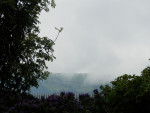
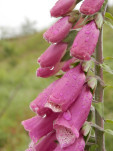
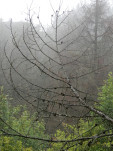
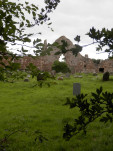
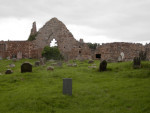
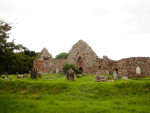
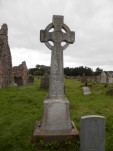
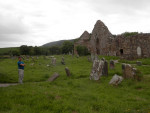
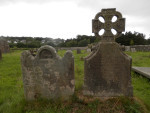
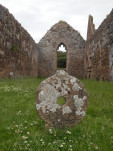
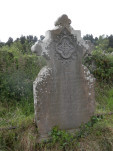
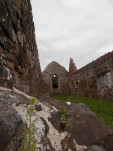
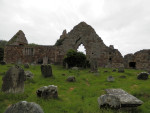
After a long, glorious day hiking up and down hills, cliffs, basalt columns, rope bridges and all, we came across a wonderful find on the way to our hotel, the ruin of Bonamargy Friary, founded around 1500 by Rory McQuillan, chief of the local family in control of the area at the time. (The plaque at the site said McQuillan, various online sites have it MacQuillan.) Beside being scenic, there was the wonderful story of The Black Nun, Julia McQuillan, who was a prophetess and recluse whose final resting place is marked by an unusual round stone at the chapel entrance. Legend has it that she haunts the chapel still, though the more religious would probably say “watches over it” instead.
Everywhere we went there were sheep, marked by patches of color on their rumps. We decided they’d all been in a massive paintball battle and still bore their war wounds with pride. (Yes, yes, we know it’s probably a way of distinguishing between flocks, but that’s not nearly as much fun now, is it?)


Lucienne Diver's Drivel
- Lucienne Diver's profile
- 522 followers



